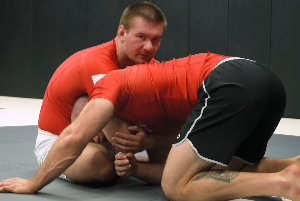The Spider Guard is a very powerful modern guard that you are likely to see in any high level gi match. This guard can be utilized for a variety of sweeps and submissions, and getting trapped inside the Spider Guard is especially frustrating.
In this lesson, Professor Volf Koslowski (a Rodrigo Medeiros Black Belt) covers three of his favorite Spider Guard passes. He shows how to link them together into a complete Spider Guard passing system.
3 Spider Guard Passes
Pass #1: The Standing Knee Pass
When passing the spider guard, never stay on your knees! You’ll be very unstable, and this gives your opponent the chance to break your angles and sweep you.

Your initial goal is to come up on your feet and make sure to (1) grab both of your opponent’s pants with a cuff grip. (2) Take a step sideways until your opponent’s legs touch the ground. (3) Step on your opponent’s inner thigh and then pull your hand to break your opponent’s grips. (4) Shove his other leg all the way to the ground, take your foot off your opponent’s thigh and then (5) pass to the other side.

Pass #2: The Hip Thrust Pass
A second effective way to pass the spider guard is with a hip thrust. The first thing that you have to do is to (1) move forward and walk on top of your opponent until you get into a position where you are almost (2) sitting down on him. Thrust your hips forward to break the spider grips, (3) grab one leg with the opposite hand. (4) Put that leg right on top of your thigh for a leg-drag position, maintain pressure, (5) then pass to side control.

Pass #3: The Shoulder Drive Pass
If your opponent prevents you from moving forward for the hip thrust, another way to pass is to (1) walk away backward until you get your opponent’s feet to the ground - but do not stay too long on this position as this allows your opponent to do an arm drag. Right away, once both of your opponent’s feet are on the ground, (2) hop on to one side and then (3) drive your shoulder on top of your opponent’s chest. Maintain pressure and then (4) establish your side control position.

How Do You Link These Passes Together?
Jiu Jitsu is all about options. There are times where you just won't be able to get one of these passes to work, and you'll need to transition to a different pass in order to shut down your opponent’s guard.
Sometimes when you get up to do the standing knee pass, a very strong opponent can prevent you from breaking their spider grip. In this case, you can go back and stand in front of your opponent while you transition to the hip thrust pass.

Similarly, if your opponent is defending the hip thrust very well, you can move backward and transition to the shoulder drive pass.

Transitioning through these passes doesn't need to happen in a particular order. Mix it up to confuse your opponent, and you’ll have a bigger chance of passing the guard.
Tricks and Tips
On the standing knee pass, if your opponent doesn’t have both of his legs on the spider, watch out for a likely sweep attempt when you try to stand up.

If that’s the case, (1) put one knee up and use that knee to (2) push off your opponent’s foot and break the grip. Never pass on the (3) same side where you broke the grip as this gives your opponent the opportunity to (4) recover guard. (5) Walk towards the other side and then (6) pass to side control.

Final Thoughts on Passing the Spider Guard
It's always a good thing to have a variety of tools in your arsenal. Mix up these three passes to confuse your opponent and neutralize their Spider Guard.
Want to Learn More?
These guard passes are part of Professor Volf's "Passing The Spider Guard" course on Gold BJJ Online Training. Sign up today to see the full course along with 25+ other courses from top instructors like Dean Lister:
Learn More
Gear Featured in this Post
Professor Volf is wearing our Calavera Gold Weave Gi in black.



